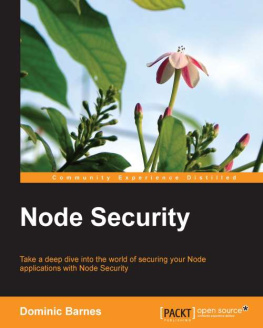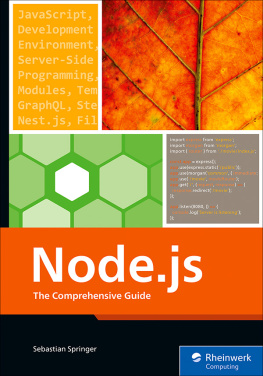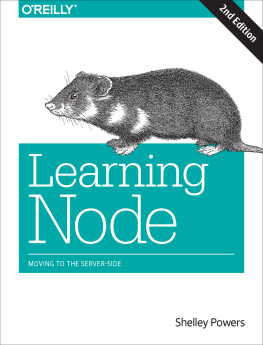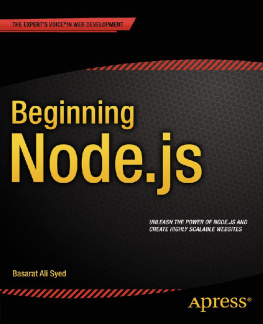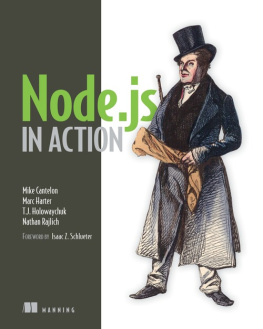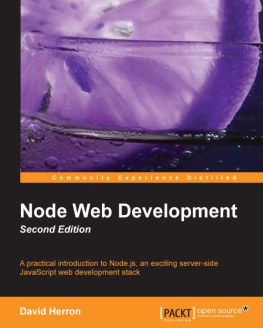Dominic Barnes - Node Security
Here you can read online Dominic Barnes - Node Security full text of the book (entire story) in english for free. Download pdf and epub, get meaning, cover and reviews about this ebook. year: 2013, publisher: Packt Publishing, genre: Computer. Description of the work, (preface) as well as reviews are available. Best literature library LitArk.com created for fans of good reading and offers a wide selection of genres:
Romance novel
Science fiction
Adventure
Detective
Science
History
Home and family
Prose
Art
Politics
Computer
Non-fiction
Religion
Business
Children
Humor
Choose a favorite category and find really read worthwhile books. Enjoy immersion in the world of imagination, feel the emotions of the characters or learn something new for yourself, make an fascinating discovery.
- Book:Node Security
- Author:
- Publisher:Packt Publishing
- Genre:
- Year:2013
- Rating:5 / 5
- Favourites:Add to favourites
- Your mark:
Node Security: summary, description and annotation
We offer to read an annotation, description, summary or preface (depends on what the author of the book "Node Security" wrote himself). If you haven't found the necessary information about the book — write in the comments, we will try to find it.
Take a deep dive into the world of securing your Node applications with Node Security
Overview
- Examine security features and vulnerabilities within JavaScript
- Explore the Node platform, including the event-loop and core modules
- Solve common security problems with available npm modules
In Detail
Node.js is a fast-growing platform for building server applications using JavaScript. Now that it is being more widely used in production settings, Node applications will start to be specifically targeted for security vulnerabilities. Protecting your users will require an understanding of attack vectors unique to Node, as well as shared with other web applications.
To secure Node.js applications, well start by helping you delve into the building blocks that make up typical Node applications. By understanding all the layers that you are building on top of, you can write code defensively and securely. In doing so, you will be able to protect your users data and your infrastructure, while still using the rock-star technology behind Node.js.
Teaching you how to secure your Node applications by learning about each of the layers you will be building on top of; starting with JavaScript itself, then the Node platform, and finally the npm module ecosystem. By starting with JavaScript, you will learn what to avoid and what to embrace. Next, we will explain the Node platform, including its unique architecture and core modules, so you know how things work under the hood. Finally, we will introduce the rich ecosystem of npm modules, including modules to help you solve the common security problems you might face. Through our handy tutorials, you will be able to write secure Node.js applications, ones that will remain online under pressure and be able to weather the most common attacks that face web applications today.
What you will learn from this book
- Master the origins of the Node.js and npm projects
- Understand the architecture, including the event-loop and asynchronous I/O
- Delve into the key aspects of avoiding some common pitfalls of JavaScript development
- Incorporate ES5s security improvements, including strict-mode
- Add static code analysis and the code-quality it promotes
- Explore the basics of proper error-handling within Node applications
- Understand the architecture of Express and Connect
- Adapt common authentication and authorization schemes
Approach
A practical and fast-paced guide that will give you all the information you need to secure your Node applications.
Who this book is written for
If you are a developer who wishes to secure your Node applications, whether you are already using Node Security in production, or are considering using it for your next project, then this book will enable you to ensure security of your applications. An understanding of JavaScript is a prerequisite, and some experience with Node is recommended, though not required.
Dominic Barnes: author's other books
Who wrote Node Security? Find out the surname, the name of the author of the book and a list of all author's works by series.

